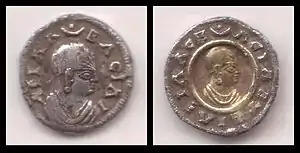Aphilas
Aphilas (early 4th century) was a King of the Kingdom of Aksum in East Africa modern day northern Ethiopia and Eritrea . He is known from the coins he minted, which are characterized by a number of experiments in imagery on the obverse, and being issued in fractions of weight that none of his successors copied.[1]
| Aphilas | |
|---|---|
 | |
| King of Aksum | |
| Predecessor | Endubis |
| Successor | Wazeba |
G.W.B. Huntingford suggests that he was the ruler who erected the anonymous inscription at Adulis known as the Monumentum Adulitanum.[2]
His coins
 Gold coin of Aphilas, discussed in the text.
Gold coin of Aphilas, discussed in the text. Silver coin of Aphilas with gold inlay, discussed in the text.
Silver coin of Aphilas with gold inlay, discussed in the text.
Aphilas produced the smallest gold coins ever minted in sub-saharan Africa, equivalent to one sixteenth of a Roman aureus. The obverse of this coin features not only his portrait, but the crescent and disc symbolic of the pre-Christian beliefs of Axum. The reverse features his name and title rendered in Greek, the lingua-franca of the civilized world at that time. Note that the "A"s lack a horizontal crossbar but have a dot placed below them instead.
His silver coin features his portrait on both the obverse and reverse with the disc and crescent (at top). The reverse reveals a distinguishing feature of Axumite coinage; gilding. The reverse interior portrait is overlaid with gold.
Notes
- S. C. Munro-Hay, Aksum: An African Civilization of Late Antiquity (Edinburgh: University Press, 1991), p. 188.
- G.W.B. Huntingford, The Historical Geography of Ethiopia (London: The British Academy, 1989), pp. 40f.